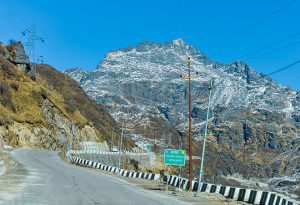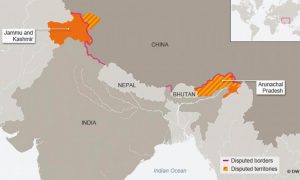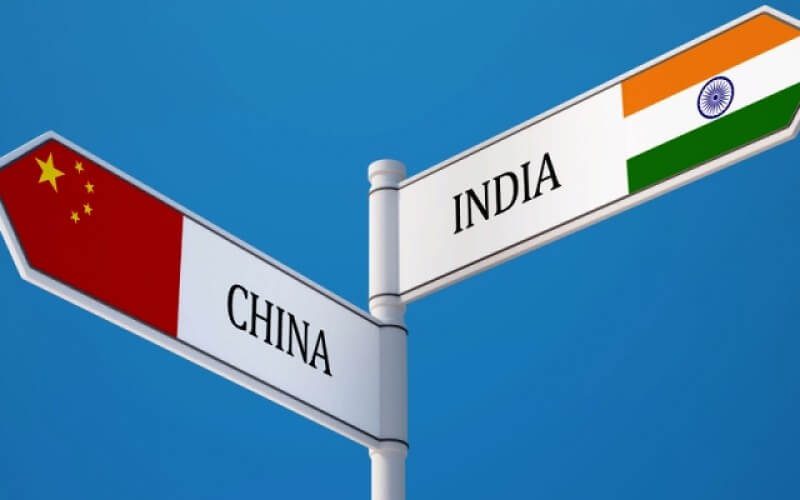Reading Time: 5 minutes
Dr Navodita analyses the growing tensions between India and China. An exclusive for Different Truths.
 The border between India and China has been volatile in the best of times and over the past few weeks, things have only taken an uglier turn. In eastern Ladakh, a skirmish between the troops broke out as India accused China of violating the unresolved frontier and challenging and obstructing the Indian patrol party.
The border between India and China has been volatile in the best of times and over the past few weeks, things have only taken an uglier turn. In eastern Ladakh, a skirmish between the troops broke out as India accused China of violating the unresolved frontier and challenging and obstructing the Indian patrol party.
Defence Minister Rajnath Singh and National Security Advisor Ajit Doval are monitoring the situation and India has made its position clear – it will continue to “defend its interests resolutely” and continue to build infrastructure close to the boundary inside Indian territory.
Defence Minister Rajnath Singh and National Security Advisor Ajit Doval are monitoring the situation and India has made its position clear – it will continue to “defend its interests resolutely” and continue to build infrastructure close to the boundary inside Indian territory.
The Indian Army has moved its battalions of three Infantry Divisions, based in Leh, forward but the country is also looking for a quick diplomatic resolution.
Significantly, Chinese President Xi Jinping also asked the People’s Liberation Army to scale up battle preparedness during the parliamentary session being held in Beijing.
Despite the escalation in tensions, a physical outbreak of war is a highly unlikely scenario in contemporary times, with both countries have reached a tacit understanding that more emphasis is needed in securing their economies than wasting resources in combat.
Despite the escalation in tensions, a physical outbreak of war is a highly unlikely scenario in contemporary times, with both countries have reached a tacit understanding that more emphasis is needed in securing their economies than wasting resources in combat. This point is even more pertinent when the COVID -19 pandemic has gripped the world and countries are battling hard to contain it.
China has over 2 million troops employed in active military service compared to 1.3 million on the Indian side. Its defence budget is four times at USD 225 billion compared to that of India, which is approximately USD 55 billion. China’s tank strength stands at a stupendous 13,000 plus compared to India’s 4,100 plus. And its armoured fighting vehicles are at a staggering 40,000; India pales into insignificance with just over 2,800. Similarly, it has ten times the rocket projectors at 2050 versus India’s 266.
As far as prowess at the sea is concerned, China has a total of 714 naval assets compared to 295 of India, with 76 submarines versus 16 owned by India. Our north-eastern neighbour also has three times the number of destroyers at 33 compared with 11 owned by us.
As far as prowess at the sea is concerned, China has a total of 714 naval assets

compared to 295 of India, with 76 submarines versus 16 owned by India. Our north-eastern neighbour also has three times the number of destroyers at 33 compared with 11 owned by us.
China has managed to produce and deploy a wide range of ballistic missiles, ranging from short-range missiles to Intercontinental Ballistic Missiles (ICBMs). India’s Defence Research and Development Organisation (DRDO) has also been conducting trials of Prithvi-1 (150 km-range) and Prithvi-2 (250 km-range) ballistic missiles, which have been inducted into the armed forces.
China has 3,000 plus total aircraft compared to over 2,000 in the Indian fleet, but importantly, it has two times the number of fighters and interceptors. It also has 507 serviceable airports compared to 346 in India.
China has 3,000 plus total aircraft compared to over 2,000 in the Indian fleet, but importantly, it has two times the number of fighters and interceptors. It also has 507 serviceable airports compared to 346 in India.
Since the 1990s, China modernised its air force at a rapid rate. In the 1990s, it had 5,000 aircraft but most of the aircraft were obsolete like the Soviet MiG 19s and MiG 21s. China is now upgrading its fleet into new-generation aircraft.
Can China deploy its entire air force on the India-China front? The answer is “no” as per Group Capt (Retd) Ravinder S Chhatwal, former Senior Fellow Centre for Air Power Studies, New Delhi, and author of the book, The Chinese Air Threat: Understanding the Reality.
Can China deploy its entire air force on the India-China front? The answer is “no” as per Group Capt (Retd) Ravinder S Chhatwal, former Senior Fellow Centre for Air Power Studies, New Delhi, and author of the book, The Chinese Air Threat: Understanding the Reality.
He says, “To launch any air campaign, fighter aircraft have to be deployed close to the border, roughly about 200 km to 300 km from the border of your enemy. Against India, China will have to deploy its fighter aircraft in Tibet and adjacent airfields in Xinjiang. China has 2,100 combat aircraft but most of them are deployed on its eastern seaboard. They cannot deploy all of them against India because of a limited number of airfields in Tibet.”
He further adds, “Now Tibet, unfortunately for them and fortunately for us, is a high-altitude plateau with mountainous terrain. They have just about five main airfields in Tibet (Kongka Dzong, Hoping, Pangta, Linzhi and Gargunsa) and another two in Xinjiang (Hotan and Kashgar). They are developing three more airfields in Tibet which are likely to be ready by 2022.”
“There is another limitation which they have. In the airfield, when you park aircraft for fighter operations, they have to be in blast protected shelters – concrete shelters. China doesn’t have any blast protected shelters at any of the airfields…”
Group Capt (Retd) Chhatwal concludes by making a pertinent point: “There is

another limitation which they have. In the airfield, when you park aircraft for fighter operations, they have to be in blast protected shelters – concrete shelters. China doesn’t have any blast protected shelters at any of the airfields. After Doklam they have realised their mistake and have now started building these in Kongka Dzong (Lhasa) airfield.”
China, however, stated Wednesday that the situation at the border with India ‘is overall stable and controllable’ and both the countries have proper mechanisms to resolve the issues through dialogue and consultation.
The foreign ministry’s remarks came a day after President Xi ordered the military to scale up the battle preparedness, visualising the worst-case scenarios and asked it to resolutely defend the country’s sovereignty.
The comments from the foreign ministry spokesman came in the backdrop of the continuing standoff between the militaries of two countries along the Line of Actual Control (LAC). The foreign ministry’s remarks came a day after President Xi ordered the military to scale up the battle preparedness, visualising the worst-case scenarios and asked it to resolutely defend the country’s sovereignty.
‘Any suggestion that Indian troops had undertaken activity across the LAC in the western sector, or Sikkim sector is not accurate. Indian troops are fully familiar with the alignment of the Line of Actual Control in the India-China border areas and abide by it scrupulously,’ MEA spokesperson Anurag Srivastava said at an online press briefing last week.
As pandemic toll begins to rise amidst easing of lockdown, India has new challenges ahead- to secure its national frontiers and hope for an economic revival at the same time.
Photo from the Internet















